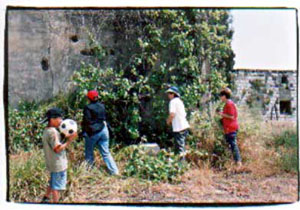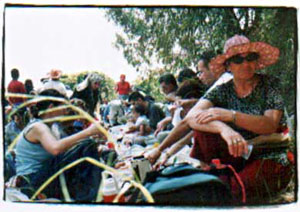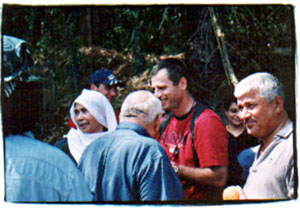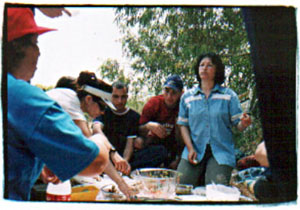At the beginning of the path to the village there is the old sabil of Miske, which has withstood the passage of time and the destruction. On the wall of the sabil appears the name of the village in Arabic and Hebrew – left over from our previous activities in the place. On our way to the ruins of the village we met members of the Shabita family, displaced from Miske, who visit the site often. Some of the family members were among those expelled from the village, and they talk to the younger generation about the history of Miske, about the tragedy of the expulsion in 1948 by Jewish forces, and about their longing for the past which may one day return. It seems that the stories and the aspirations are no less important to the second, the third, and even the fourth generation of the displaced.
The place is almost completely destroyed. The remains of the village that are left are the structure of the school (two large stone structures with a few windows, sooty and abandoned), the cemetery, and an exposed, shattered structure of the old mosque. The structure of the new mosque was also destroyed. The lands of the village are divided today among Ramat Hakovesh, Sde Warburg, Mishmeret, Kfar Hess, Tel Mond, Bitzra, Rishpon, and others. At the site where the village houses stood, there is now a large eucalyptus grove. The uprooted families say: 'The state of Israel, after destroying the village and its structures, planted in their place, via the Jewish National Fund, a forest of trees in order to blur the footprints that cry out from the past, and to cover up the crime and the truth.' 'Zionist camouflage to cover up the ruins of the village,' as one of the refugees said. A stranger coming upon this place without previous knowledge, could not know what had been cruelly destroyed. Together with the displaced people of Miske, members of the Shabita family, we posted a sign with the name of the village in Arabic and in Hebrew on the hill of eucalyptus trees.
Moussa Shabita points to the remains of the village and says that his father, who was among those expelled, would take him to the destroyed village, tell him about his memories and about his longing for the agricultural village life of Miske. He says that the lands of the village reached Sidna Ali and Kibbutz Shfayim. Ismat, like other members of the generation that did not experience the physical expulsion, knows the story and the circumstances of the expulsion well from her father's stories
Moussa Shabita was 23 years old at the time of the expulsion. He says that there were good neighborly relations with Ramat Hakovesh, Ramat Yochanan, and Tel Asher. In the end, he remembers, the good neighborliness ended in disappointment for the residents of Miske. On April 17, 1948, residents of the village received a message from their neighbors that it would be preferable for them to leave, otherwise they would be expelled by the armed Jewish forces. On April 19 the village leaders understood that they leave for Tira or a refugee camp in Sidna Ali. Most of the people of the village preferred to reach Tira, Qalqilya, and Tulkarem. (After the 1948 war some of those expelled returned from Qalqilya and Tulkarem to Tira. There are those who live until today in the refugee camps in the occupied territories). On the day of the expulsion the Mukhtar remained in the village as well as another person who refused to leave. The rest succeeded in taking a great portion of their domestic belongings. Moussa claims that the primary importance of the right of return is for the residents of the refugee camps. He reasons that that he will not be able to return to the village, although there is always a certain hope. With tears in his eyes Moussa says, "I never forgot and I will never forget the village. I teach my two children the history of the Nakba and remind them of the village."
Hitam Shabita was a young girl at the time of the expulsion. She remembers that in the beginning they found places in Jius (near Kochav Yair of today) and after a few months they left for Tira. She talks with great pain that her father has not returned to the village since the expulsion because of his hurt and longing.
Gazi Shabita was 13 years old at the time of the expulsion. His journey of self discovery after the shock and crisis of the Nakba, his desire to fight the establishment, led him to join the Israeli Community party in 1957, where he was an active member over many years. Gazi says that until the 14th century there was a Crusader settlement in the area. Due to illness and war the place was abandoned for 200 years. Then the new settlers arrived – the fathers and mothers of the people of Miske today. He remembers well the structures of the village and the fields, the mutual help, almost like a commune, between members of the village.
In Miske, Gazi remembers, they did not know much about the expulsions and the massacres in the Arab villages by the Jewish forces, beyond the general knowledge that the Jews wanted the Arabs to leave. During WWI the residents of the village were forced to leave their homes for a few days, and they hoped that the abandonment in April 1948 would also be merely temporary. The neighboring Jewish settlements (such as Tel Asher, Ramat Hakovesh, Sde Warburg) did not accept that Miske should give up its existence, and that was following many years of good neighborly relations. There was a negotiated agreement for mutual defense in the beginning of 1948 between the Jewish communities and Miske, to prevent acts of mutual aggression. With the outbreak of the war the matter was dropped, the Jewish communities refused the agreement, and at the request of the Jewish army, they hinted to the people of Miske that they should leave and that none of them would be willing to protect the village. Since the neighboring settlements were not willing to protect the village from the Jewish forces, and since none of the leaders of Miske wanted to take responsibility for violence and killing, the people of the village understood that they had no option but to leave.
Gazi smiles as he remembers how on the day of the expulsion he returned from school in Tira and saw people leaving. For a moment he was happy that he wouldn't need to strain his feet walking the long distance from Miske to the school in Tira. Only later did he understand the scope of the tragedy.
Until 1952, Gazi remembers, the expelled people of the village never gave up hope of returning. That same year, the Israeli authorities destroyed the houses of the village. Then he understood that the Nakba would be his eternal inheritance. Gazi supports the full right of return: To bring back those who want to return and to financially compensate those who prefer to remain where they are now. He stands on his demand that Israel must recognize the right of return and its responsibility for creating the refugee problem. This will be a starting point for a just and fair negotiation. He would be satisfied to get back 75% of the 200 dunams of the village lands that belong to him, and to be compensated for the rest. But more than that, his soul is tormented by the fact that the Jewish-Israeli public and the government do not recognize their responsibility for the Nakba.
After an (excellent) friendly shared meal together, we said our goodbyes to the Shabita family

Miske Tour 2003

Miske Tour 2003 (8)

Miske Tour 2003 (10)

Miske Tour 2003 (9)



